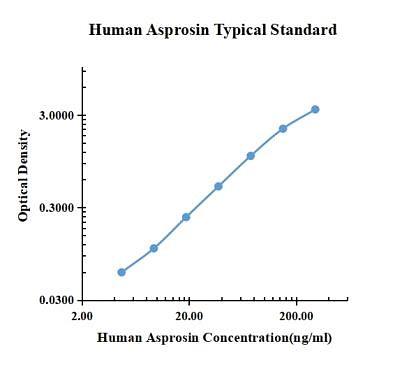Human Asprosin enzyme-linked immunoassay kit
| Specification | 96 Test |
|---|---|
| Sensitivity | 0.78 ng/ml (50 μl) |
| Standard Curve Range | 4.69~300 ng/ml |
| Standard Curve Gradient | 7 Points |
| Number of Incubations | 2 |
| Detectable sample | Liquid phase sample of soluble substances. For example: serum, plasma, cell culture supernatant, tissue grinding liquid, etc. |
| Sample Volume | 50 μl |
| Type | Ready-to-Use |
| Operation Duration | 90min |

| ng/ml | O.D. | Average | Corrected | |
|---|---|---|---|---|
| 0.00 | 0.0407 | 0.0468 | 0.0438 | |
| 4.69 | 0.1037 | 0.1032 | 0.1035 | 0.0597 |
| 9.38 | 0.1406 | 0.1638 | 0.1522 | 0.1085 |
| 18.75 | 0.2698 | 0.2895 | 0.2797 | 0.2359 |
| 37.50 | 0.5256 | 0.5766 | 0.5511 | 0.5074 |
| 75.00 | 1.0950 | 1.1600 | 1.1275 | 1.0838 |
| 150.00 | 2.3230 | 2.0280 | 2.1755 | 2.1318 |
| 300.00 | 3.6020 | 3.3780 | 3.4900 | 3.4463 |
Precision
| Intra-assay Precision | Inter-assay Precision | |||||
| Sample Number | S1 | S2 | S3 | S1 | S2 | S3 |
| 22 | 22 | 22 | 6 | 6 | 6 | |
| Average(ng/ml) | 6.4 | 29.6 | 112.8 | 5.9 | 31.2 | 118.1 |
| Standard Deviation | 0.3 | 1.2 | 5.9 | 0.3 | 1.3 | 5.4 |
| Coefficient of Variation(%) | 4.0 | 4.0 | 5.2 | 5.1 | 4.2 | 4.6 |
Intra-assay Precision (Precision within an assay) Three samples of known concentration were tested twenty times on one plate to assess intra-assay precision.
Inter-assay Precision (Precision between assays) Three samples of known concentration were tested six times on one plate to assess intra-assay precision.
Spike Recovery
Sample Values
| Sample Matrix | Sample Evaluated | Range (ng/ml) | Detectable (%) | Mean of Detectable (ng/ml) |
|---|---|---|---|---|
| Serum | 30 | 3.35-128.74 | 100 | 34.32 |
Serum/Plasma – Thirty samples from apparently healthy volunteers were evaluated for the presence of Asprosin in this assay. No medical histories were available for the donors.
Product Data Sheet
Background: Asprosin
Asprosin is a new type of adipocytokine discovered by Romere et al. in 2016. It is mainly produced and secreted by white adipocytes, which can bind to the receptors on the surface of hepatocytes on the one hand, stimulate the glucose output of hepatocytes, and directly increase blood sugar; On the other hand, it can penetrate the blood-brain barrier, activate the neuronal activity of agRP gene-associated protein (AgRP) associated with feeding-related in the hypothalamic center, and inhibit the neuronal activity of anorexia-related opioid-melanocyte corticogen (POMC), promote food intake, and indirectly exert a hypoglycemic effect.

